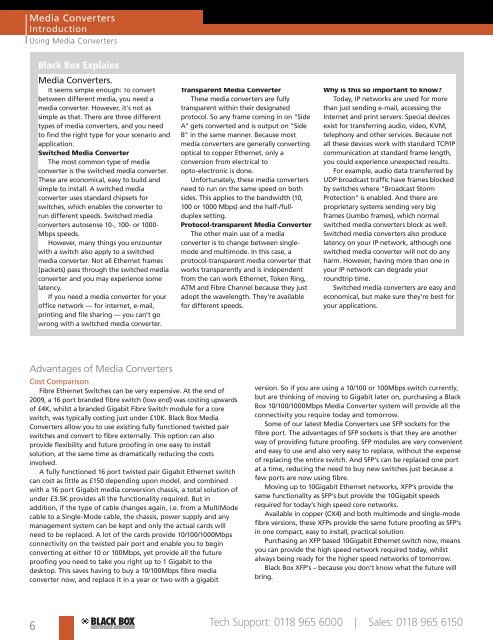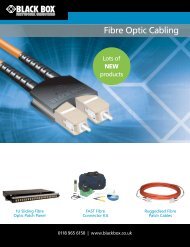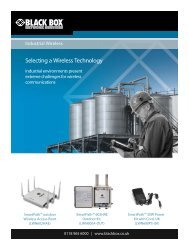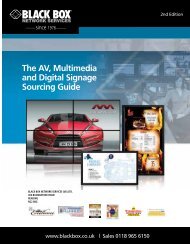Download PDF - Black Box (UK)
Download PDF - Black Box (UK)
Download PDF - Black Box (UK)
Create successful ePaper yourself
Turn your PDF publications into a flip-book with our unique Google optimized e-Paper software.
Media Converters<br />
Introduction<br />
Using Media Converters<br />
<strong>Black</strong> <strong>Box</strong> Explains<br />
Media Converters.<br />
It seems simple enough: To convert<br />
between different media, you need a<br />
media converter. However, it's not as<br />
simple as that. There are three different<br />
types of media converters, and you need<br />
to find the right type for your scenario and<br />
application.<br />
Switched Media Converter<br />
The most common type of media<br />
converter is the switched media converter.<br />
These are economical, easy to build and<br />
simple to install. A switched media<br />
converter uses standard chipsets for<br />
switches, which enables the converter to<br />
run different speeds. Switched media<br />
converters autosense 10-, 100- or 1000-<br />
Mbps speeds.<br />
However, many things you encounter<br />
with a switch also apply to a switched<br />
media converter. Not all Ethernet frames<br />
(packets) pass through the switched media<br />
converter and you may experience some<br />
latency.<br />
If you need a media converter for your<br />
office network — for internet, e-mail,<br />
printing and file sharing — you can't go<br />
wrong with a switched media converter.<br />
Transparent Media Converter<br />
These media converters are fully<br />
transparent within their designated<br />
protocol. So any frame coming in on "Side<br />
A" gets converted and is output on "Side<br />
B" in the same manner. Because most<br />
media converters are generally converting<br />
optical to copper Ethernet, only a<br />
conversion from electrical to<br />
opto-electronic is done.<br />
Unfortunately, these media converters<br />
need to run on the same speed on both<br />
sides. This applies to the bandwidth (10,<br />
100 or 1000 Mbps) and the half-/fullduplex<br />
setting.<br />
Protocol-transparent Media Converter<br />
The other main use of a media<br />
converter is to change between singlemode<br />
and multimode. In this case, a<br />
protocol-transparent media converter that<br />
works transparently and is independent<br />
from the can work Ethernet, Token Ring,<br />
ATM and Fibre Channel because they just<br />
adopt the wavelength. They're available<br />
for different speeds.<br />
Why is this so important to know<br />
Today, IP networks are used for more<br />
than just sending e-mail, accessing the<br />
Internet and print servers. Special devices<br />
exist for transferring audio, video, KVM,<br />
telephony and other services. Because not<br />
all these devices work with standard TCP/IP<br />
communication at standard frame length,<br />
you could experience unexpected results.<br />
For example, audio data transferred by<br />
UDP broadcast traffic have frames blocked<br />
by switches where "Broadcast Storm<br />
Protection" is enabled. And there are<br />
proprietary systems sending very big<br />
frames (Jumbo frames), which normal<br />
switched media converters block as well.<br />
Switched media converters also produce<br />
latency on your IP network, although one<br />
switched media converter will not do any<br />
harm. However, having more than one in<br />
your IP network can degrade your<br />
roundtrip time.<br />
Switched media converters are easy and<br />
economical, but make sure they're best for<br />
your applications.<br />
Advantages of Media Converters<br />
Cost Comparison<br />
Fibre Ethernet Switches can be very expensive. At the end of<br />
2009, a 16 port branded fibre switch (low end) was costing upwards<br />
of £4K, whilst a branded Gigabit Fibre Switch module for a core<br />
switch, was typically costing just under £10K. <strong>Black</strong> <strong>Box</strong> Media<br />
Converters allow you to use existing fully functioned twisted pair<br />
switches and convert to fibre externally. This option can also<br />
provide flexibility and future proofing in one easy to install<br />
solution, at the same time as dramatically reducing the costs<br />
involved.<br />
A fully functioned 16 port twisted pair Gigabit Ethernet switch<br />
can cost as little as £150 depending upon model, and combined<br />
with a 16 port Gigabit media conversion chassis, a total solution of<br />
under £3.5K provides all the functionality required. But in<br />
addition, if the type of cable changes again, i.e. from a MultiMode<br />
cable to a Single-Mode cable, the chassis, power supply and any<br />
management system can be kept and only the actual cards will<br />
need to be replaced. A lot of the cards provide 10/100/1000Mbps<br />
connectivity on the twisted pair port and enable you to begin<br />
converting at either 10 or 100Mbps, yet provide all the future<br />
proofing you need to take you right up to 1 Gigabit to the<br />
desktop. This saves having to buy a 10/100Mbps fibre media<br />
converter now, and replace it in a year or two with a gigabit<br />
version. So if you are using a 10/100 or 100Mbps switch currently,<br />
but are thinking of moving to Gigabit later on, purchasing a <strong>Black</strong><br />
<strong>Box</strong> 10/100/1000Mbps Media Converter system will provide all the<br />
connectivity you require today and tomorrow.<br />
Some of our latest Media Converters use SFP sockets for the<br />
fibre port. The advantages of SFP sockets is that they are another<br />
way of providing future proofing. SFP modules are very convenient<br />
and easy to use and also very easy to replace, without the expense<br />
of replacing the entire switch. And SFP’s can be replaced one port<br />
at a time, reducing the need to buy new switches just because a<br />
few ports are now using fibre.<br />
Moving up to 10Gigabit Ethernet networks, XFP’s provide the<br />
same functionality as SFP’s but provide the 10Gigabit speeds<br />
required for today’s high speed core networks.<br />
Available in copper (CX4) and both multimode and single-mode<br />
fibre versions, these XFPs provide the same future proofing as SFP’s<br />
in one compact, easy to install, practical solution.<br />
Purchasing an XFP based 10Gigabit Ethernet switch now, means<br />
you can provide the high speed network required today, whilst<br />
always being ready for the higher speed networks of tomorrow.<br />
<strong>Black</strong> <strong>Box</strong> XFP’s – because you don’t know what the future will<br />
bring.<br />
6 Tech Support: 0118 965 6000 | Sales: 0118 965 6150









